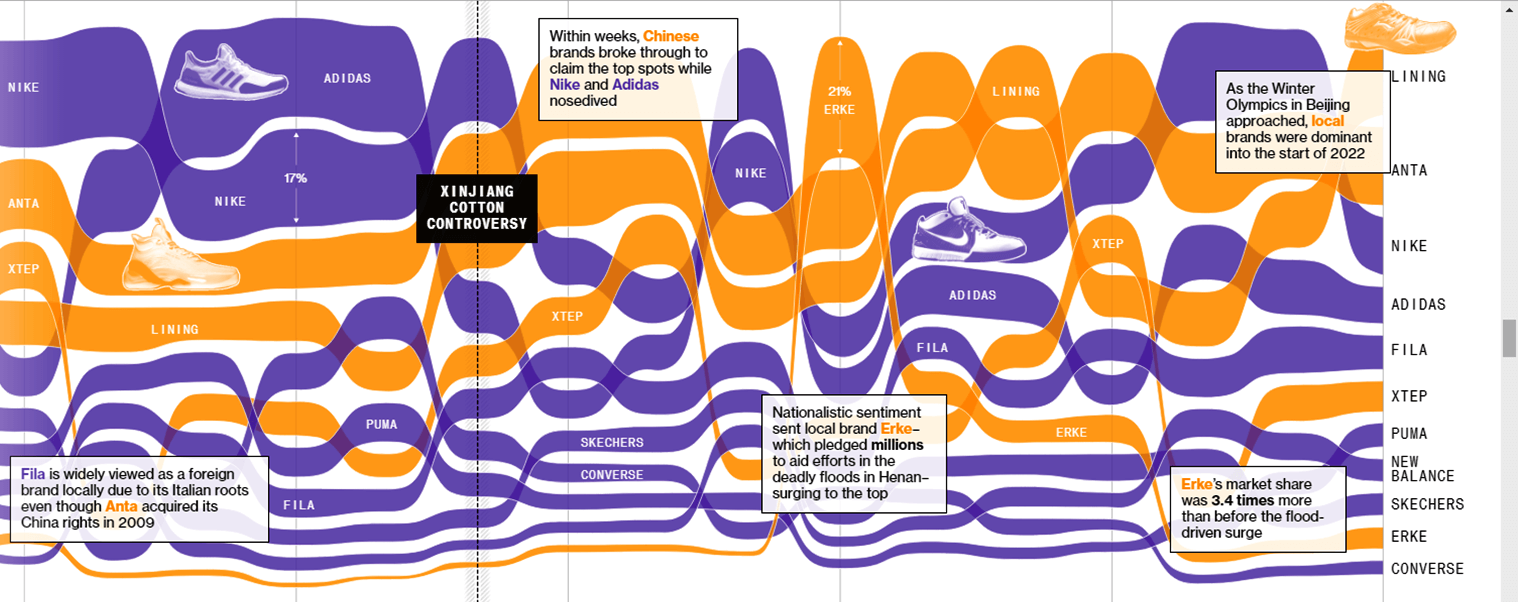![]()
From Bloomberg: Data show sustained consumer pivot away from Western brands (partial graphic above from Bloomberg)
From Nike’s Fiscal 2022 Q2 report: Revenues in Greater China and APLA declined, largely due to lower levels of available inventory resulting from COVID-19 related factory closures
Source: How Nationalism in China Has Dethroned Nike, Adidas
Bloomberg recently ran a report on Nike and adidas’ ongoing difficulties in the largest sneaker market in the world. China has always been a source of pride for Nike and adidas as sales there buffered decisions in the U.S. over the last 5 years. Both the Three Stripes and the Swoosh have removed wholesale accounts in the U.S. Nike’s removal was more noticeable and as I tracked store closures starting in 2013, with Nike ramping up their DTC strategy and removing their reliance on reporting Futures, the impact could be felt beyond small mom and pop shops and gained the attention of media and analysts with The Sports Authority bankruptcy.
Since Nike’s major statement during their 2017 Investor’s Day, the company has made it a point to tout their growth in China, “Our full year NIKE, Inc. revenues increased 19 percent on a reported basis or 14 percent compared to fiscal year 2019, reflecting growth across all Geographies and Converse, including seven consecutive years of double-digit, currency-neutral** growth for our Greater China business.” This double-digit growth is now in jeopardy and Nike’s ability to proudly promote Nike Direct and Digital growth, which correlates to the removal of Nike accounts, could come back to haunt them, just as adidas’ less covered removal of accounts could hurt them as well.
Mom and pop shops aren’t cash cows, but the stores offer brand building and brand loyalty. There is no secret that since Nike began leaving more retail locations Puma has seen considerable growth, to the tune of 7.7 billion, a 33% sales increase in 2021:
The politics of China often weigh on the economy of China and countries abroad due to imports, but the nationalism being seen currently is very apparent on the sneaker side of things as China’s own brands have skyrocketed after the Xinjiang Cotton Controversy. Forbes has an amazing illustration of the shift. Use this link to click through and see the chart:
https://www.bloomberg.com/graphics/2022-china-nationalistic-online-shoppers/
[T]hey’re (Nike and adidas) on the backfoot amid the steady drumbeat of Chinese nationalism. Both brands struggle to get top local athletes to endorse them, say analysts, especially during the run-up to the Winter Olympics in Beijing.
Analysts note that sustaining growth post nationalism will be key to knowing whether adidas and Nike will regain their positions in China. But, with both Nike and adidas placing more pressure on their wholesale business in the U.S., they have left considerable holes in the marketplace and as those chains left behind by The Swoosh and The Three Stripes begin to learn about life without the popular brands, a new problem could emerge for the companies relying on a foreign market that can be unpredictable and challenging.


